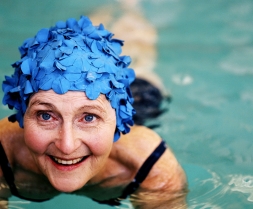Aqua Fitness: A low impact physical activity for the active aging adult
Thursday, November 13, 2014 - 10:15

Aqua fitness for older adults, especially for those with limited mobility can be an excellent way of staying active. It is a low impact form of exercise that is accessible to all swimming levels and abilities. Working out in the water allows for greater range of motion without putting too much strain on the body, prevents overheating and enables participants to exercise for a longer period of time.
For older adults and notably for those with arthritis, joint pain and associated complications, aqua fitness exercises can provide:
- Aerobic Exercise – strengthens the heart, keeps arteries clear, helps manage chronic diseases and reduces age related health risks.
- Resistance training exercise - increases muscle mass and improves bone density.
- Flexibility exercise - maintains or improves range of motion.
- Balance exercise – improves balance and reduces the risk of falling.
Water helps to support body weight by lessening the stress on joints and muscles. For those who have a difficult time getting their daily recommended physical activity on land due to injuries or other circumstances, it can be a great alternative to staying active as one gets healthy.
Aqua fitness also incorporates a number of techniques from various activities such as:
- Walking
- Running
- Various arm movements such as arm rotations, treading water and lifting weights.
- Cross country skiing
- Jumping
An exercise environment such as an aqua fitness class can be an opportunity to socialize which in turn can help keep individuals motivated to maintain the activity. Aqua fitness is an excellent option for the aging population and those with limited mobility since it can help older adults be more independent, assist in managing illness and pain, and maybe even reverse some of the effects of aging.
References from the SIRC Collection:
1. Fisken A, Waters D, Hing W, Steele M, Keogh J. Perception and Responses to Different Forms of Aqua-Based Exercise Among Older Adults With Osteoarthritis. International Journal Of Aquatic Research & Education. February 2014;8(1):32-52.
2. L. Spinney J, Millward H. Active Living Among Older Canadians: A Time-Use Perspective Over 3 Decades. Journal Of Aging & Physical Activity. January 2014;22(1):103-113.
3. Plachy J, Kovách M, Bognár J. IMPROVING FLEXIBILITY AND ENDURANCE OF ELDERLY WOMEN THROUGH A SIX-MONTH TRAINING PROGRAMME. Human Movement. March 2012;13(1):22-27.
4. The wonders of water training. Active Living. March 2012;21(2):N3.
5. Vécseyné Kovách M, Kopkáné Plachy J, Bognár J, Olvasztóné Balogh Z, Barthalos I. Effects of Pilates and aqua fitness training on older adults' physical functioning and quality of life. Biomedical Human Kinetics. November 2, 2013;5(1):22-27.
6. Wolff J, Warner L, Ziegelmann J, Wurm S. What do targeting positive views on ageing add to a physical activity intervention in older adults? Results from a randomised controlled trial. Psychology & Health. August 2014;29(8):915-932.